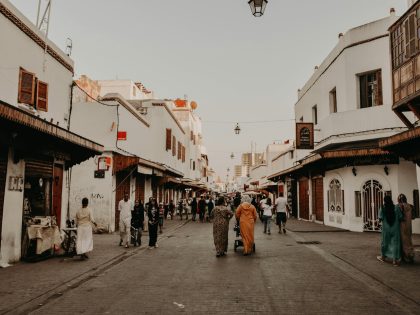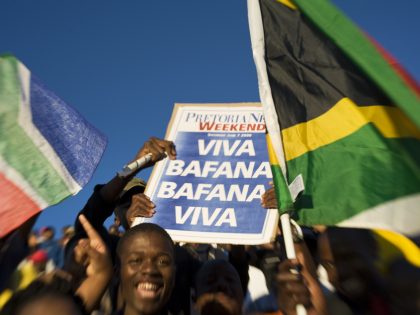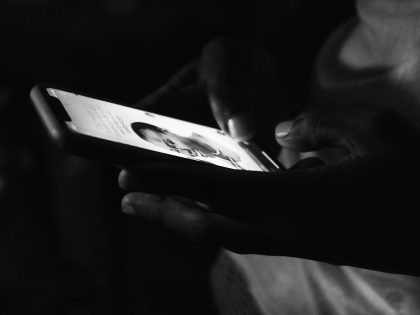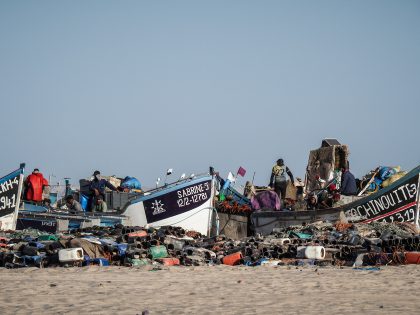Pizza Aid
What happens when humanitarian agencies ditch the tried-and-trusted fundraising method of splashing disaster porn across screens and news pages?

Londow Chow, via Flickr CC.
What kind of images can possibly fill in for the altogether enthralling scene of non-white bodies wracked with overwhelming pain, images which express nothing but pure need? With Action Against Hunger’s new ad campaign, we’re beginning to find out what an alternative might look like.
As good students of Don Draper, we all know that advertising is based on one thing: happiness. According to Don this entails at least three things: smelling the interior of a new car, freedom from fear, and a billboard on the side of the road that screams with reassurance that whatever you’re doing is okay.
Which is all very well, provided an ad follows the underlying logic of advertising: lying to people to make us want something we don’t really need.
But with humanitarian advertising something strange happens. It would appear that when humanitarian groups solicit money from consumers of mass media an altogether different transaction is being proposed, namely one in which an advertiser tells the truth and compels people to hand over surplus cash so that the real and urgent needs of others can be met. At least, that’s something like how it should go.
Trouble is, the old consumer mentality dies very hard, and the two modes of advertising are all jumbled up. There aren’t two different kinds of advertising space, one for commercial ads and another for humanitarian appeals.
(This is one reason why self-evidently anti-humanitarian companies like BP, ExxonMobil, Shell, Chevron and others have lately gone to such conspicuous lengths to try to convince everybody that they’re actually much more like groups such as Greenpeace, or Medecins Sans Frontières, or the Disasters Emergency Committee, than they are like the sort of oil-spilling, icecap-melting, Iraq-invasion-lobbying, Saro-Wiwa-murdering transnational shysters that we might otherwise have quite innocently supposed them to be.)
In any case, the suspicion has long lurked that gawping at pictures of starving children in Africa might have somehow crossed over into the Don Draper realm of advertising, and become a source of happiness for the kindly Western reader. (And this mix-up, it must be stressed, has nothing whatsoever to do with the noble tradition of racism in Western culture extending back to Hegel and beyond.)
In fundraising campaigns from the Biafran War onwards it became clear that the most effective way of raising money for starving (almost always African) populations was also the way that luxuriated in the vulnerability of the hungry, that enjoyed not only Western power to save but Western power per se. And it now seems that more and more people are coming to the conclusion that weaving images of some of the world’s most vulnerable people into our ever brasher, crasser mediascape is not ok.
So what to make of Action Against Hunger’s latest efforts to depart from all this? What is the face of hunger advertising that has decided not to show a face?
Well, as you might expect, there’s nobody in the ads. Nobody black, nobody brown, nobody at all. Instead there’s a tiny pepperoni pizza in a yawning pizza-box, and a string of seven (light brown) paper dolls, one of which is very thin. No jutting ribs or flies around the eyes, this is hunger imagined in a slimmed-down version of the universal symbol for the men’s bathroom, and “universal” is indeed the buzzword the ad company return to when explaining the ad.
There’s no arid Horn of Africa background, no crumbling shacks. Instead we’re dealing with what Action Against Hunger describes as “abstract imagery”, and these days that can only mean a plain white background and some tasteful drop-shadows. If anywhere’s going to come out of this looking permanently desperate and crisis-ridden, it’s more likely to be your Macbook than the continent of Africa, and that’s got to be a good thing.
The “copy” itself is shorn of racial and national identifiers, and the emergency is conceived of as a norm graspable in steady annual figures: “3.5 million children die each year from acute malnutrition. Take action. Save a child.”
Surprisingly, the New York Times decided to report on their own advertising and showed an approving interest in the new approach, despite having harbored for many years probably the most hardline fetishist of the African body in pain, Nicholas D. Kristof, whose work they continue to publish quite openly.
There are two weird things about the ads.
The first is the pizza, a miniscule aperitif drowning in a sea of cardboard packaging, the kind of meagre repast we’ll surely all have to make do with when Herman Cain is sworn in. The pizza add has been attacked by NYU’s Paul Light, who wants the ad “redesigned to focus on good food, not what many givers would see as a very unhealthy option.” Light is understandably concerned that people will mistakenly suppose that Action Against Hunger is simply a lobbying group for more and bigger pizzas.
The second weird thing is that the whole appeal is sponsored by Ultimat Vodka (slogan: “Live Ultimately”), whose logo appears in the bottom corner of each ad and which professes to be “tired” of hunger.
And it’s at this point, as we think about millions of acutely malnourished children, and then of a pizza the size of cookie, and then of a luxury Polish vodka made from both grains and potatoes, that we might feel compelled to wonder, like a character in a J.G. Ballard novel: “What sort of scenario is the mind quietly stitching together?”



















